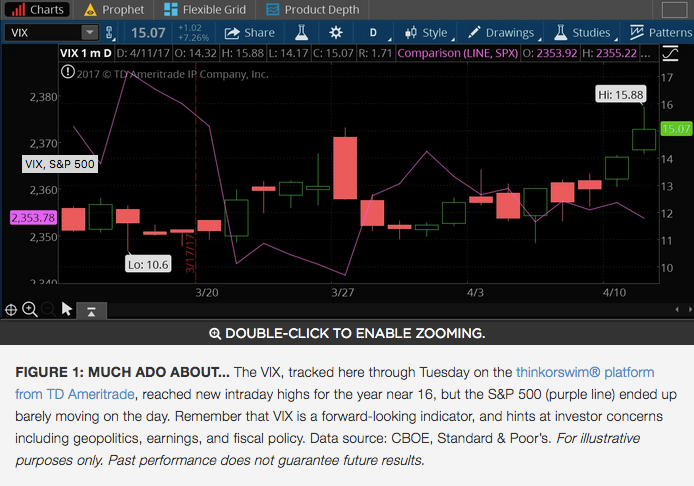Geopolitical concerns keep stalking the markets, helping so-called “safe haven” investments and putting pressure on equities
ahead of the fast-approaching earnings season.
The cautious stance that prevailed earlier this week seemed to continue Wednesday, judging by some key indicators. For instance,
the Japanese yen reached five-month highs against the dollar. The yen is sometimes thought of as a safety play in times of investor
fear.
Gold – another so-called “risk-off” investment – reached multi-month highs as well, climbing above $1,275 an ounce. Concerns
about U.S./Russia relations, Syria and North Korea, the coming French election, and U.S. politics may all play into investor
caution.
Though the markets ended Tuesday close to where they started, volatility continues to climb, with VIX hitting its highest levels
since November. The rising volatility may reflect those same geopolitical worries, and could also hint at some trepidation ahead of
earnings season. That said, the S&P 500 (SPX) on Tuesday managed to close above the recent pivot point of 2350, and perhaps
found some technical support at the 50-day moving average of 2349, according to Briefing.com. We’ll see if support in that area can
hold again today.
Speaking of earnings season, Thursday marks the start of the quarterly bank earnings parade,
with Citigroup Inc (NYSE: C), JPMorgan
Chase & Co. (NYSE: JPM), and Wells Fargo &
Co (NYSE: WFC) all due before the open. Last time out,
these three put pretty good wood on the ball and helped cheer the broader markets.
Q1 earnings expectations for the financial sector are high. According to FactSet Research, earnings are expected to grow at
14.8% year-over-year in the first quarter, the highest earnings growth projection across all 11 sectors.
One question is how the continued strength in bonds might affect the financial sector. Ten-year U.S. Treasury yields are
stumbling, moving below key technical support of 2.3% early Wednesday. The bond market rally came despite a better than expected
Job Openings and Labor Turnover Survey (JOLTS) report Tuesday that showed 5.743 million job openings in February, a gain of around
100,000 from the prior month. Keep an eye on Friday’s retail sales report, which may provide insight into how the jobs picture may
be affecting consumers. There isn’t much economic data on the calendar today, however.
Trading has generally been pretty light this week, and that was the case Tuesday as well. With the markets closed for a holiday
on Friday, people may be a little bit nervous to add on to their positions.

Mark the Calendar
Once Congress returns from recess, it faces a deadline with possible ramifications for the stock market. On April 28, the
current continuing resolution that keeps the government running expires, meaning Congress needs to act quickly to keep doors open
at national parks and federal agencies for the five months left in the fiscal year. In the past, shutdowns and the possibility of
shutdowns helped create volatility in the markets, and if a shutdown did occur, it could mean delays in some key government
economic data. But with Republicans in control of both the White House and Congress, a shutdown scenario seems less likely than
back in 2013 when we last saw one. Even so, it could be prudent for investors to keep this on their radar and watch Washington to
see if Congress can resolve a few key issues that go into avoiding any interruption.
Marquer le Calendrier
That means “mark the calendar” in French. And the date to watch is April 23, the French election. Normally, elections in France
don’t tend to have huge market impacts here in the U.S., but this one is a bit different. That’s because it features Marine Le Pen,
of the far right National Front party, who currently leads several other candidates in the polling, news reports say. This is only
the first round, but if polls are right, it looks like Le Pen may have a good chance of making it to the next round. It’s early to
predict how this might play out, but a strong performance by Le Pen could perhaps give the dollar a boost against the euro and
bring back more memories of Brexit, when England decided to leave the European Union. Any sign of major political change in Europe
deserves attention from U.S. investors, simply because Europe is such a huge trading partner and also a key player in geopolitical
stability.
Caught on Camera
We've seen again this week how an incident captured with a phone camera and posted on social media can negatively affect a major
stock. There’s not a lot an average investor can do to avoid one of his or her companies being embarrassed on social media, but
that said, some sectors, by their very nature, could be more susceptible than others. These include sectors where operations are
right out front for everyone to see and easily capture, including energy and consumer discretionary. There’s no sense in avoiding
these sectors, which can be important in maintaining a well-diversified portfolio, but it’s also smart to be prepared for any
possibility and also not to lose your head when something bad happens and the stock goes down. It might make more sense in that
situation to look closely at the company from a broader perspective and see if it’s well positioned from an industry and financial
perspective, and also watch to see what sorts of measures it takes publicly to avoid such incidents in the future. Sometimes a bad
day for a stock can turn out to be a good wake-up call that helps strengthen the company down the road.
© 2017 Benzinga.com. Benzinga does not provide investment advice. All rights reserved.